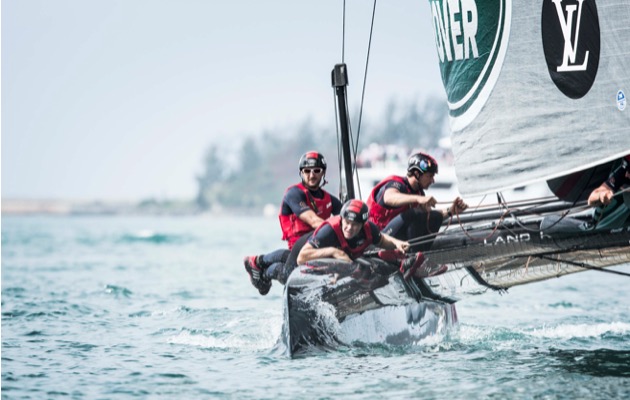The breeze may have been so low that it was below the below the bottom limit for racing while being more fluky than a British gravel pit breeze, but it didn’t stop teams from learning valuable lessons
As with any practice race there will be those who go home grateful that their results didn’t count while others will wish the day’s action had been for points. Friday saw teams in both categories at the end of the two race practice session ahead of the Bermuda AC World Series event that takes place this weekend.
Among those going home smiling with their chests puffed out was Dean Barker’s SoftBank Team Japan who had excelled in the fluky conditions of the day winning the first race and leading the second until the lottery leg in from the course to the finish off the town quay.
Barker and Co. would also have been happy at turning their fortunes around after Thursday’s near capsize during training along with rudder issues that dogged them throughout the day. Friday was their day.
This was not the case for Artemis and Emirates Team New Zealand, at least not in the first race when they got dropped off the back of the fleet.
For Ainslie’s Land Rover BAR the day was one of constant catch up which the team did well, at least in the first race, rescuing a third from a more dismal looking positioning earlier in the first race. In the second the team took the lead for the first half of the race before a big change in the breeze saw the fleet turn inside out.
Throughout the day the breeze barely exceeded 4 knots, well below the 6 knot minimum required to get a real race off and away. But with all the toys out on the water there was no reason not to give it a go.
And despite the light winds lottery, there still appeared to be lessons being learned by the fleet. One of which was the use of code zeros upwind.
To start with it was Groupama Team France who caught the fleet unawares by flying theirs on the upwind leg to good effect. Gradually others followed suit until in the second race the tactic was used universally.
“Until today we hadn’t considered using a code zero in anger upwind,” Ainslie told me after the race. “It’s not impossible for conditions to drop to this level during a race so while we might not start in such light winds we might end up having to race in them. Knowing how to cope is important.”
The second lesson to be learned was how teams could reduce drag by dropping their jibs when the code zero was set. Again, what started as one or two trying it turned into fleet wide behaviour come the end of the day.
And the third lesson of the day was that there is one wind direction where a thermal breeze could well influence conditions, north easterly.
This light sound odd but one of the features of Bermuda is that it is a long skinny island that has insufficient land mass to generate a sea breeze as it can’t build big enough thermals.
But in north easterly the breeze blows over the longest stretch of the land and creates a long cloud street that runs parallel to the island. Apparently it’s called Morgan’s Cloud and is a well known feature to the locals. This then stretches out over the race course area and dumps breeze on the course. At least it did today.
So while the day was short on action and well below the minimum limits on wind strength required to race for real, (today saw around 4 knots where 6 knots is the minimum), it wasn’t short on lessons and material for the teams’ nightly de-brief.
Saturday’s racing starts at 1410 local
And…just in case you missed yesterday’s fun aboard Land Rover BAR…..




